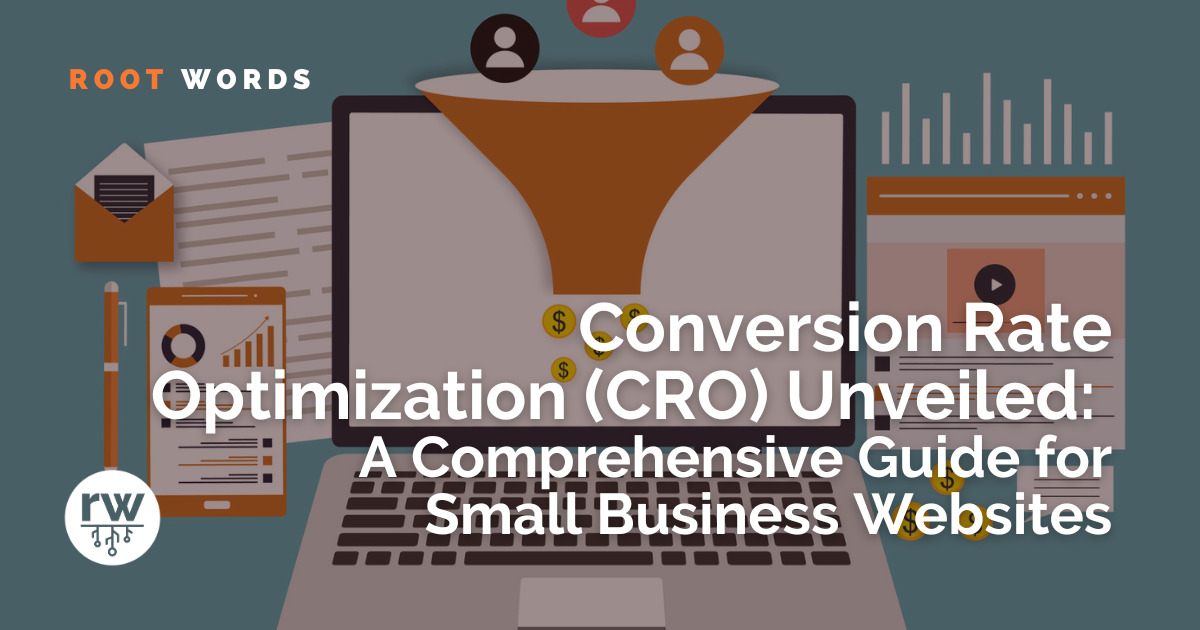Conversion Rate Optimization (CRO) Unveiled: A Comprehensive Guide for Small Business Websites

In a time where the success of a small business often hinges on its online presence, conversion rate optimization (CRO) emerges as a pivotal strategy. We’ve gathered information tailored for small business owners that will unravel the intricacies of CRO and offer actionable insights to transform website visits into tangible conversions.
Let’s embark on a journey into the world of CRO, exploring compelling calls-to-action, the art of A/B testing and other strategies to maximize the conversion potential of your website.
Understanding the Essence of Conversion Rate Optimization
Defining Conversion Rate Optimization (CRO):
At its core, CRO is the systematic process of enhancing a website to boost the percentage of visitors who take a desired action, whether it’s making a purchase, filling out a form or subscribing to a newsletter. It’s about making your website work smarter, not harder.
Example: An e-commerce site focusing on CRO might optimize its checkout process, ensuring a seamless and user-friendly experience that encourages visitors to complete their purchases.
Why CRO Matters for Small Businesses:
For small businesses operating in competitive markets, every website visit is a valuable opportunity. CRO ensures these visits translate into meaningful actions, amplifying the impact of your digital presence and maximizing return on investment (ROI).
Example: A local service provider, such as a boutique fitness studio, can benefit significantly from CRO by optimizing its website to convert visitors into class bookings or membership sign-ups.
Elements of Effective Conversion Rate Optimization
Compelling Calls-to-Action (CTAs):
The journey toward conversion often begins with a persuasive call to action. Crafting compelling CTAs that prompt visitors to take the desired action is an art. It involves strategic placement, engaging language and a clear value proposition.
Example: A software solutions provider might use a CTA like “Unlock Your Business Potential Today” strategically placed on a page detailing their services.
Optimized Landing Pages:
Landing pages play a crucial role in CRO. An optimized landing page aligns with the visitor’s intent, delivering a cohesive experience and minimizing distractions. Clear messaging and relevant content are key components.
Example: An online store running a promotional campaign can create a dedicated landing page showcasing discounted products and emphasizing limited-time offers.
A/B Testing Strategies:
A/B testing involves comparing two versions of a webpage to determine which performs better. It’s a powerful tool for small businesses to iteratively refine their websites based on data-driven insights.
Example: A travel agency might A/B test different variations of its booking form to identify the format that results in more completed bookings.
Strategic Use of Images and Multimedia:
Visual elements are potent tools in CRO. The strategic use of high-quality images, videos and infographics can capture attention, convey information effectively and guide visitors toward conversion points.
Example: An interior design service can utilize before-and-after images on its homepage, showcasing the transformative impact of its services.
Actionable Tips for Small Business Owners
Understand Your Audience:
The foundation of an effective CRO is a deep understanding of your target audience. Analyze user behavior, preferences and pain points to tailor your website to meet their needs.
Example: A pet grooming service might discover through analytics that its audience is particularly interested in organic and pet-friendly grooming products.
Simplify the Conversion Process:
A complicated conversion process is a major deterrent. Streamline forms, minimize steps and eliminate unnecessary fields to make the conversion process smooth and user-friendly.
Example: An online subscription box service can optimize its sign-up process by asking for essential information only and providing a progress indicator.
Responsive Design for Multi-Device Users:
Users access websites through various devices. Ensure your website is responsive, offering a seamless experience across desktops, tablets and mobile devices.
Example: A local restaurant’s website should be designed to provide a user-friendly menu experience on both desktop and mobile, with easy options for online reservations.
Measuring and Adapting for Ongoing Success
Utilize Analytics Tools:
Leverage analytics tools to track and measure your website’s performance. Insights into user behavior, traffic sources and conversion funnels can guide ongoing optimization efforts.
Example: An online tutoring service can use analytics to identify popular subjects and optimize its homepage to prominently feature these offerings.
Regularly Review and Update Content:
Content plays a crucial role in CRO. Regularly review and update your content to ensure it remains relevant, engaging and aligned with your current business goals.
Example: A local bookstore might update its homepage to feature bestselling books, promotions or upcoming author events.
—
Conversion rate optimization has emerged as a catalyst for small businesses aiming not just for clicks but meaningful conversions. From the strategic placement of CTAs to the continuous refinement through A/B testing, every element plays a role in enhancing the user journey and driving desired actions. As you navigate the landscape of CRO, remember that optimization is an ongoing process, and each insight gained is a step toward maximizing the potential of your online presence.
For personalized guidance and strategic implementation of CRO strategies for your small business, reach out to Rooted Web. Let’s transform your website into a conversion powerhouse, ensuring that every click counts toward the growth of your business.
